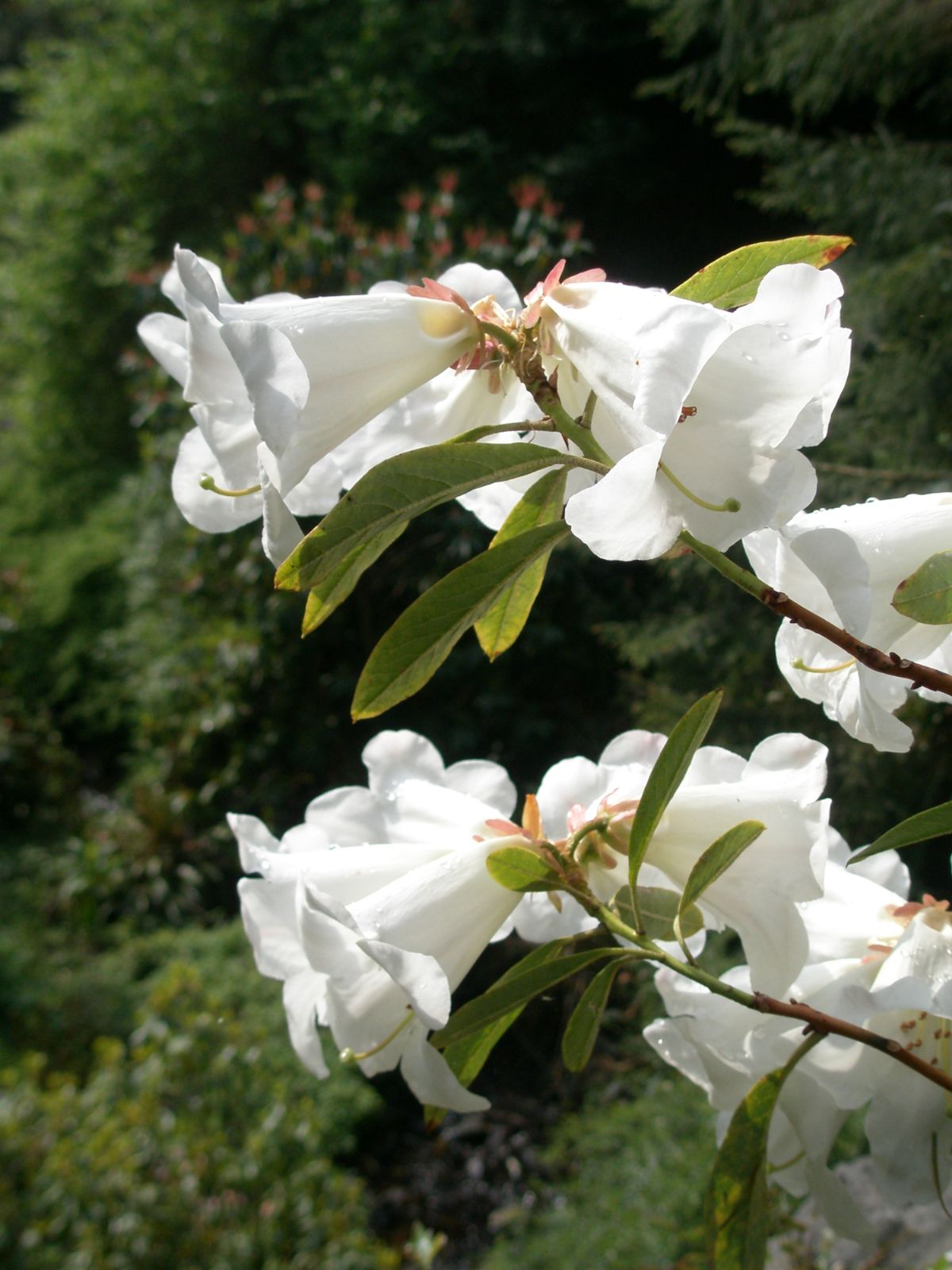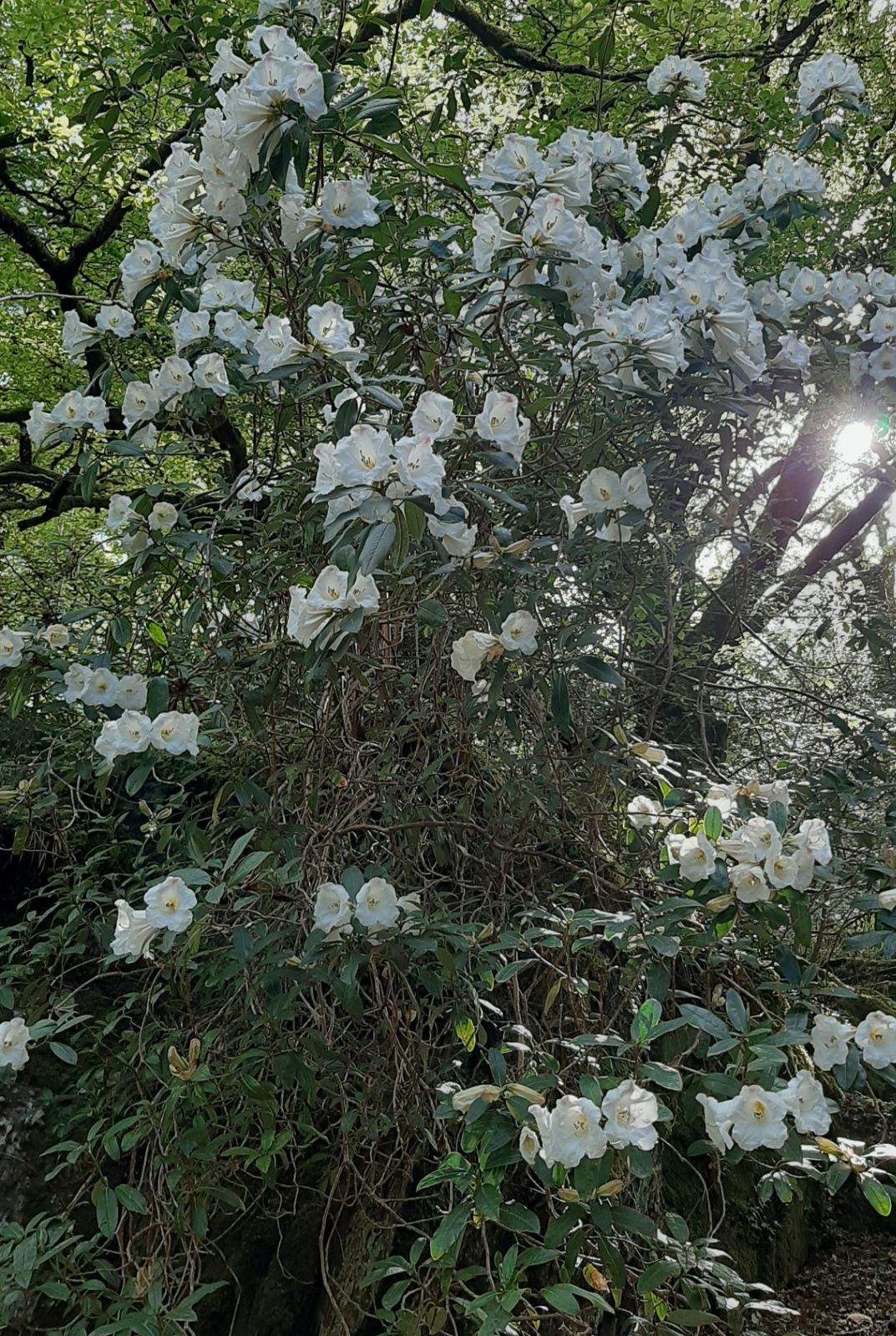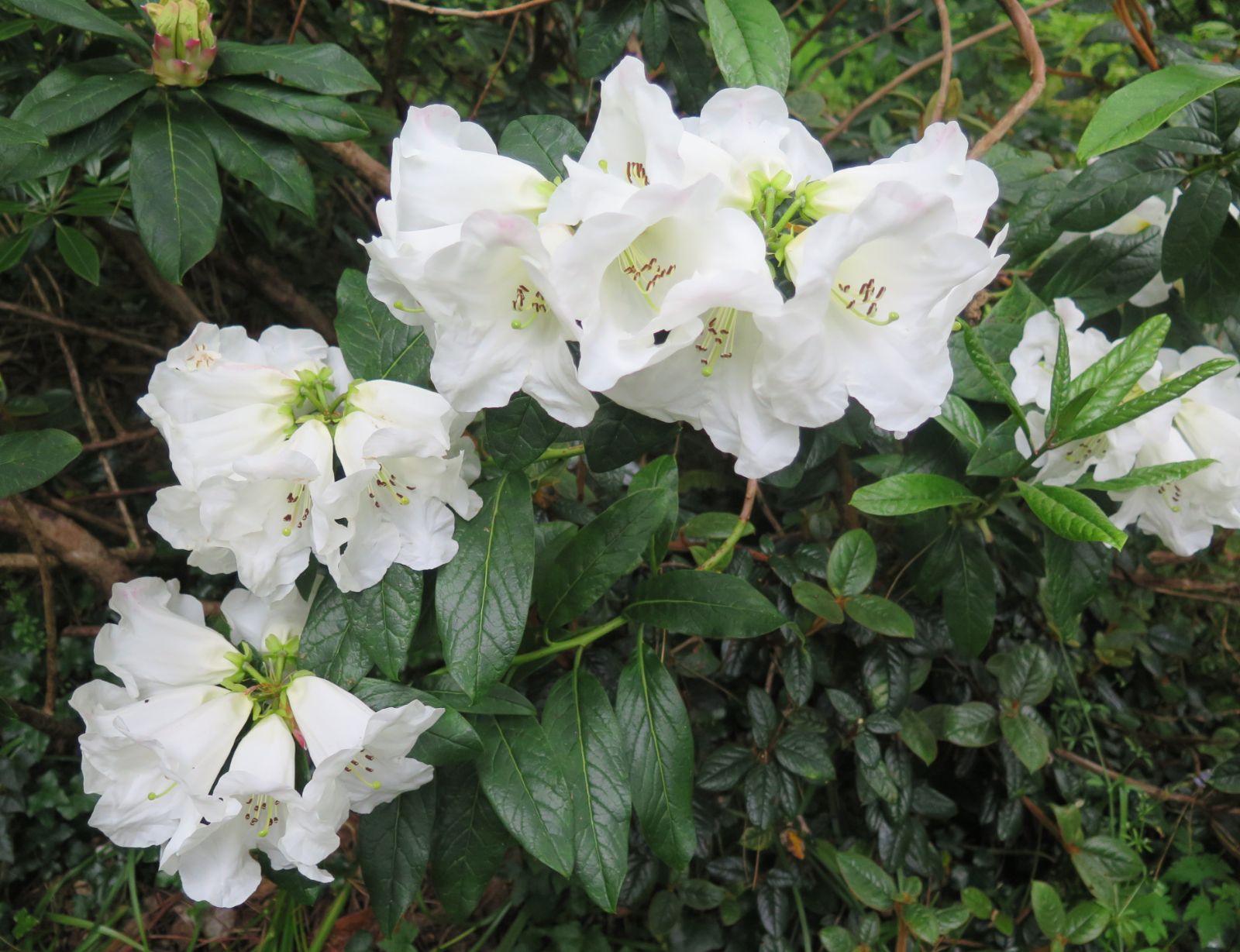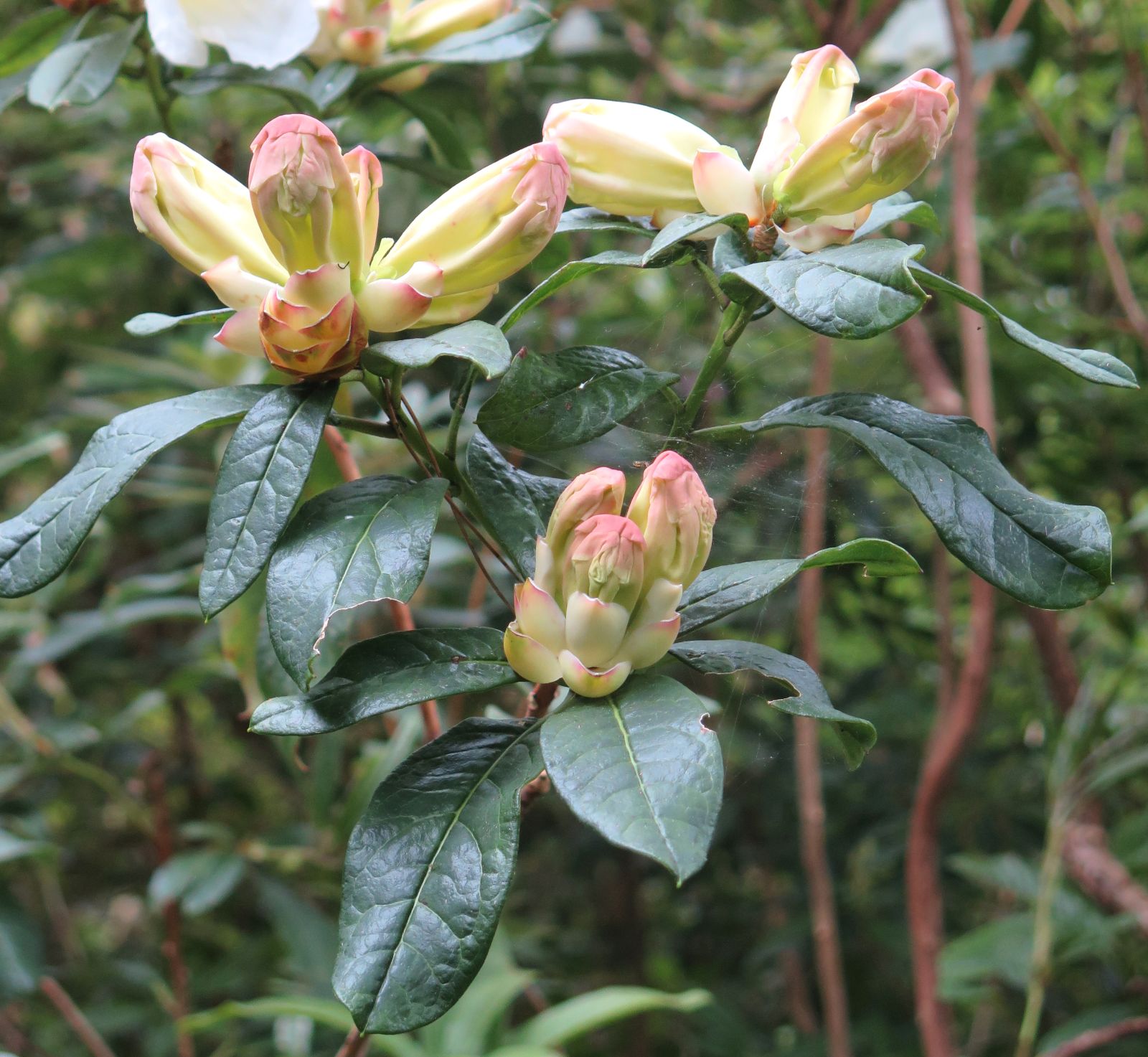Rhododendron lindleyi
Sponsor
Kindly sponsored by
Peter Norris, enabling the use of The Rhododendron Handbook 1998
Credits
Article from Bean's Trees and Shrubs Hardy in the British Isles
Recommended citation
'Rhododendron lindleyi' from the website Trees and Shrubs Online (treesandshrubsonline.
Genus
- Rhododendron
- Subsect. Maddenia
Synonyms
- Rhododendron bhotanicum C. B. Clarke
Infraspecifics
Other taxa in genus
- Menziesia multiflora
- Rhododendron aberconwayi
- Rhododendron acuminatum
- Rhododendron adenogynum
- Rhododendron adenopodum
- Rhododendron adenosum
- Rhododendron aequabile
- Rhododendron afghanicum
- Rhododendron aganniphum
- Rhododendron agastum
- Rhododendron × agastum
- Rhododendron alabamense
- Rhododendron albertsenianum
- Rhododendron albiflorum
- Rhododendron albrechtii
- Rhododendron album
- Rhododendron alticolum
- Rhododendron alutaceum
- Rhododendron amagianum
- Rhododendron ambiguum
- Rhododendron amesiae
- Rhododendron anagalliflorum
- Rhododendron annae
- Rhododendron anthopogon
- Rhododendron anthopogonoides
- Rhododendron anthosphaerum
- Rhododendron anwheiense
- Rhododendron aperantum
- Rhododendron araiophyllum
- Rhododendron arborescens
- Rhododendron arboreum
- Rhododendron arfakianum
- Rhododendron argipeplum
- Rhododendron argyrophyllum
- Rhododendron arizelum
- Rhododendron armitii
- Rhododendron atlanticum
- Rhododendron atropurpureum
- Rhododendron atrovirens
- Rhododendron augustinii
- Rhododendron aureum
- Rhododendron auriculatum
- Rhododendron aurigeranum
- Rhododendron auritum
- Rhododendron austrinum
- Rhododendron baenitzianum
- Rhododendron bagobonum
- Rhododendron baileyi
- Rhododendron bainbridgeanum
- Rhododendron balangense
- Rhododendron balfourianum
- Rhododendron barbatum
- Rhododendron basilicum
- Rhododendron batemanii
- Rhododendron bathyphyllum
- Rhododendron beanianum
- Rhododendron beesianum
- Rhododendron beyerinckianum
- Rhododendron bhutanense
- Rhododendron blackii
- Rhododendron boothii
- Rhododendron brachyanthum
- Rhododendron brachycarpum
- Rhododendron bracteatum
- Rhododendron brevistylum
- Rhododendron brookeanum
- Rhododendron bryophilum
- Rhododendron bureavii
- Rhododendron bureavioides
- Rhododendron burmanicum
- Rhododendron burttii
- Rhododendron buxifolium
- Rhododendron caesium
- Rhododendron calendulaceum
- Rhododendron caliginis
- Rhododendron callimorphum
- Rhododendron calophytum
- Rhododendron calostrotum
- Rhododendron caloxanthum
- Rhododendron calvescens
- Rhododendron camelliiflorum
- Rhododendron campanulatum
- Rhododendron campylocarpum
- Rhododendron campylogynum
- Rhododendron camtschaticum
- Rhododendron canadense
- Rhododendron x candelabrum
- Rhododendron canescens
- Rhododendron capitatum
- Rhododendron carneum
- Rhododendron carolinianum
- Rhododendron carrii
- Rhododendron carringtoniae
- Rhododendron catacosmum
- Rhododendron catawbiense
- Rhododendron caucasicum
- Rhododendron cephalanthum
- Rhododendron cerasinum
- Rhododendron chaetomallum
- Rhododendron chamaethomsonii
- Rhododendron championiae
- Rhododendron charitopes
- Rhododendron chionanthum
- Rhododendron chlorops
- Rhododendron christi
- Rhododendron christianae
- Rhododendron chryseum
- Rhododendron chrysodoron
- Rhododendron ciliatum
- Rhododendron ciliicalyx
- Rhododendron cinnabarinum
- Rhododendron citriniflorum
- Rhododendron clementinae
- Rhododendron coelicum
- Rhododendron coeloneuron
- Rhododendron collettianum
- Rhododendron columbianum
- Rhododendron commonae
- Rhododendron complexum
- Rhododendron concinnum
- Rhododendron coriaceum
- Rhododendron coryanum
- Rhododendron cowanianum
- Rhododendron coxianum
- Rhododendron crassifolium
- Rhododendron crassum
- Rhododendron crinigerum
- Rhododendron cruttwellii
- Rhododendron cuffeanum
- Rhododendron culminicolum
- Rhododendron cumberlandense
- Rhododendron cuneatum
- Rhododendron cyanocarpum
- Rhododendron dalhousiae
- Rhododendron dasypetalum
- Rhododendron dauricum
- Rhododendron davidii
- Rhododendron davidsonianum
- Rhododendron decandrum
- Rhododendron × decipiens
- Rhododendron decorum
- Rhododendron degronianum
- Rhododendron dendricola
- Rhododendron dendrocharis
- Rhododendron denudatum
- Rhododendron desquamatum
- Rhododendron detonsum
- Rhododendron dianthosmum
- Rhododendron diaprepes
- Rhododendron dichroanthum
- Rhododendron dielsianum
- Rhododendron dignabile
- Rhododendron dilatatum
- Rhododendron dimitrium
- Rhododendron diphrocalyx
- Rhododendron discolor
- Rhododendron dryophyllum
- Rhododendron eclecteum
- Rhododendron × edgarianum
- Rhododendron edgeworthii
- Rhododendron elegantulum
- Rhododendron elliottii
- Rhododendron ericoides
- Rhododendron eriocarpum
- Rhododendron eriogynum
- Rhododendron erosum
- Rhododendron × erythrocalyx
- Rhododendron esetulosum
- Rhododendron eudoxum
- Rhododendron eurysiphon
- Rhododendron exasperatum
- Rhododendron excellens
- Rhododendron faberi
- Rhododendron facetum
- Rhododendron falconeri
- Rhododendron fallacinum
- Rhododendron fargesii
- Rhododendron farrerae
- Rhododendron fastigiatum
- Rhododendron faucium
- Rhododendron ferrugineum
- Rhododendron fictolacteum
- Rhododendron flammeum
- Rhododendron flavidum
- Rhododendron fletcherianum
- Rhododendron flinckii
- Rhododendron floccigerum
- Rhododendron floribundum
- Rhododendron flumineum
- Rhododendron formosanum
- Rhododendron formosum
- Rhododendron forrestii
- Rhododendron fortunei
- Rhododendron fragariiflorum
- Rhododendron fulgens
- Rhododendron fulvastrum
- Rhododendron fulvum
- Rhododendron galactinum
- Rhododendron gardenia
- Rhododendron genestierianum
- Rhododendron giulianettii
- Rhododendron glanduliferum
- Rhododendron glaucophyllum
- Rhododendron glischroides
- Rhododendron glischrum
- Rhododendron goodenoughii
- Rhododendron goreri
- Rhododendron gracilentum
- Rhododendron grande
- Rhododendron griersonianum
- Rhododendron griffithianum
- Rhododendron groenlandicum
- Rhododendron grothausii
- Rhododendron gymnocarpum
- Rhododendron habrotrichum
- Rhododendron haematodes
- Rhododendron hanceanum
- Rhododendron haofui
- Rhododendron headfortianum
- Rhododendron hedyosmum
- Rhododendron heftii
- Rhododendron heliolepis
- Rhododendron hellwigii
- Rhododendron hemitrichotum
- Rhododendron hemsleyanum
- Rhododendron herzogii
- Rhododendron hidakanum
- Rhododendron × hillieri
- Rhododendron himantodes
- Rhododendron hippophaeoides
- Rhododendron hirsutum
- Rhododendron hirtipes
- Rhododendron hodgsonii
- Rhododendron hongkongense
- Rhododendron hooglandii
- Rhododendron hookeri
- Rhododendron horlickianum
- Rhododendron houlstonii
- Rhododendron huianum
- Rhododendron hunnewellianum
- Rhododendron hyacinthosmum
- Rhododendron hylaeum
- Rhododendron hyperythrum
- Rhododendron hypoleucum
- Rhododendron imberbe
- Rhododendron impeditum
- Rhododendron imperator
- Rhododendron inconspicuum
- Rhododendron indicum
- Rhododendron inopinum
- Rhododendron insigne
- Rhododendron intranervatum
- Rhododendron intricatum
- Rhododendron irroratum
- Rhododendron japonicum
- Rhododendron jasminiflorum
- Rhododendron javanicum
- Rhododendron johnstoneanum
- Rhododendron kaempferi
- Rhododendron kanehirae
- Rhododendron kawakamii
- Rhododendron keiskei
- Rhododendron keleticum
- Rhododendron kendrickii
- Rhododendron kesangiae
- Rhododendron keysii
- Rhododendron kiusianum
- Rhododendron kiyosumense
- Rhododendron kongboense
- Rhododendron konori
- Rhododendron kyawii
- Rhododendron lacteum
- Rhododendron laetum
- Rhododendron lagopus
- Rhododendron lanatoides
- Rhododendron lanatum
- Rhododendron lanceolatum
- Rhododendron lanigerum
- Rhododendron lapponicum
- Rhododendron latoucheae
- Rhododendron laudandum
- Rhododendron lepidostylum
- Rhododendron lepidotum
- Rhododendron leptanthum
- Rhododendron leptocarpum
- Rhododendron leptothrium
- Rhododendron leucaspis
- Rhododendron leucogigas
- Rhododendron levinei
- Rhododendron lindaueanum
- Rhododendron lochiae
- Rhododendron longesquamatum
- Rhododendron longiflorum
- Rhododendron longipes
- Rhododendron longistylum
- Rhododendron loranthiflorum
- Rhododendron lowii
- Rhododendron lowndesii
- Rhododendron luciferum
- Rhododendron ludlowii
- Rhododendron ludwigianum
- Rhododendron lukiangense
- Rhododendron luraluense
- Rhododendron luteiflorum
- Rhododendron lutescens
- Rhododendron luteum
- Rhododendron lyi
- Rhododendron lysolepis
- Rhododendron macabeanum
- Rhododendron macgregoriae
- Rhododendron macrophyllum
- Rhododendron macrosepalum
- Rhododendron maculiferum
- Rhododendron maddenii
- Rhododendron magnificum
- Rhododendron maius
- Rhododendron makinoi
- Rhododendron malayanum
- Rhododendron mallotum
- Rhododendron mariesii
- Rhododendron martinianum
- Rhododendron maximum
- Rhododendron maybarae
- Rhododendron meddianum
- Rhododendron megacalyx
- Rhododendron megeratum
- Rhododendron mekongense
- Rhododendron micranthum
- Rhododendron microgynum
- Rhododendron micromalayanum
- Rhododendron microphyton
- Rhododendron mimetes
- Rhododendron minus
- Rhododendron molle
- Rhododendron mollicomum
- Rhododendron mollyanum
- Rhododendron monosematum
- Rhododendron montroseanum
- Rhododendron morii
- Rhododendron moulmainense
- Rhododendron moupinense
- Rhododendron mucronatum
- Rhododendron mucronulatum
- Rhododendron multicolor
- Rhododendron multinervium
- Rhododendron myrtifolium
- Rhododendron nakaharae
- Rhododendron nakotiltum
- Rhododendron neoglandulosum
- Rhododendron neriiflorum
- Rhododendron nervulosum
- Rhododendron nigroglandulosum
- Rhododendron nipponicum
- Rhododendron nitidulum
- Rhododendron nivale
- Rhododendron niveum
- Rhododendron noriakianum
- Rhododendron notiale
- Rhododendron nudipes
- Rhododendron nuttallii
- Rhododendron oblongifolium
- Rhododendron obtusum
- Rhododendron occidentale
- Rhododendron ochraceum
- Rhododendron oldhamii
- Rhododendron orbiculare
- Rhododendron orbiculatum
- Rhododendron oreodoxa
- Rhododendron oreotrephes
- Rhododendron orthocladum
- Rhododendron ovatum
- Rhododendron pachypodum
- Rhododendron pachysanthum
- Rhododendron pachytrichum
- Rhododendron papillatum
- Rhododendron paradoxum
- Rhododendron parmulatum
- Rhododendron parryae
- Rhododendron parvifolium
- Rhododendron pauciflorum
- Rhododendron pemakoense
- Rhododendron pendulum
- Rhododendron pentaphyllum
- Rhododendron perakense
- Rhododendron peregrinum
- Rhododendron periclymenoides
- Rhododendron phaeochitum
- Rhododendron phaeochrysum
- Rhododendron piercei
- Rhododendron pingianum
- Rhododendron × planecostatum
- Rhododendron planetum
- Rhododendron pleianthum
- Rhododendron pleistanthum
- Rhododendron pocophorum
- Rhododendron poluninii
- Rhododendron polyanthemum
- Rhododendron polycladum
- Rhododendron polylepis
- Rhododendron ponticum
- Rhododendron praestans
- Rhododendron praeteritum
- Rhododendron praetervisum
- Rhododendron praevernum
- Rhododendron prattii
- Rhododendron preptum
- Rhododendron primuliflorum
- Rhododendron principis
- Rhododendron prinophyllum
- Rhododendron pronum
- Rhododendron proteoides
- Rhododendron protistum
- Rhododendron pruniflorum
- Rhododendron prunifolium
- Rhododendron przewalskii
- Rhododendron pseudochrysanthum
- Rhododendron pubescens
- Rhododendron pudorosum
- Rhododendron pulchrum
- Rhododendron pumilum
- Rhododendron purdomii
- Rhododendron purpureiflorum
- Rhododendron quadrasianum
- Rhododendron quinquefolium
- Rhododendron racemosum
- Rhododendron ramsdenianum
- Rhododendron rarilepidotum
- Rhododendron rarum
- Rhododendron recurvoides
- Rhododendron reticulatum
- Rhododendron retivenium
- Rhododendron retusum
- Rhododendron rex
- Rhododendron rhodoleucum
- Rhododendron rigidum
- Rhododendron ripense
- Rhododendron ririei
- Rhododendron robinsonii
- Rhododendron roseatum
- Rhododendron rothschildii
- Rhododendron roxieanum
- Rhododendron rubiginosum
- Rhododendron rubineiflorum
- Rhododendron rubropilosum
- Rhododendron rufum
- Rhododendron rugosum
- Rhododendron rupicola
- Rhododendron russatum
- Rhododendron saisiuense
- Rhododendron saluenense
- Rhododendron sanctum
- Rhododendron sanguineum
- Rhododendron santapaui
- Rhododendron sargentianum
- Rhododendron saxicolum
- Rhododendron saxifragoides
- Rhododendron sayeri
- Rhododendron scabridibracteum
- Rhododendron scabrifolium
- Rhododendron scabrum
- Rhododendron schlippenbachii
- Rhododendron schoddei
- Rhododendron scintillans
- Rhododendron scopulorum
- Rhododendron searleanum
- Rhododendron searsiae
- Rhododendron seinghkuense
- Rhododendron selense
- Rhododendron semibarbatum
- Rhododendron semnoides
- Rhododendron serotinum
- Rhododendron serpyllifolium
- Rhododendron sessilifolium
- Rhododendron setosum
- Rhododendron × sheilae
- Rhododendron shepherdii
- Rhododendron sherriffii
- Rhododendron shweliense
- Rhododendron sidereum
- Rhododendron siderophyllum
- Rhododendron sikangense
- Rhododendron simiarum
- Rhododendron simsii
- Rhododendron sinofalconeri
- Rhododendron sinogrande
- Rhododendron smirnowii
- Rhododendron × sochadzeae
- Rhododendron solitarium
- Rhododendron sororium
- Rhododendron souliei
- Rhododendron sperabile
- Rhododendron sperabiloides
- Rhododendron sphaeroblastum
- Rhododendron spiciferum
- Rhododendron spilotum
- Rhododendron spinuliferum
- Rhododendron stamineum
- Rhododendron stapfianum
- Rhododendron stenopetalum
- Rhododendron stenophyllum
- Rhododendron stevensianum
- Rhododendron stewartianum
- Rhododendron strigillosum
- Rhododendron suaveolens
- Rhododendron subansiriense
- Rhododendron subsessile
- Rhododendron succothii
- Rhododendron sulfureum
- Rhododendron sumatranum
- Rhododendron superbum
- Rhododendron sutchuenense
- Rhododendron taggianum
- Rhododendron taliense
- Rhododendron tanastylum
- Rhododendron tapetiforme
- Rhododendron tashiroi
- Rhododendron tatsienense
- Rhododendron telmateium
- Rhododendron temenium
- Rhododendron tephropeplum
- Rhododendron thayerianum
- Rhododendron thomsonii
- Rhododendron thymifolium
- Rhododendron tolmachevii
- Rhododendron tomentosum
- Rhododendron tosaense
- Rhododendron traillianum
- Rhododendron trichanthum
- Rhododendron trichocladum
- Rhododendron trichostomum
- Rhododendron triflorum
- Rhododendron tsariense
- Rhododendron tschonoskii
- Rhododendron tschonoskyi
- Rhododendron tsusiophyllum
- Rhododendron tuba
- Rhododendron ungernii
- Rhododendron uniflorum
- Rhododendron uvariifolium
- Rhododendron vaccinioides
- Rhododendron valentinianum
- Rhododendron vaseyi
- Rhododendron veitchianum
- Rhododendron venator
- Rhododendron vernicosum
- Rhododendron verruculosum
- Rhododendron versteegii
- Rhododendron vesiculiferum
- Rhododendron vialii
- Rhododendron vilmorinianum
- Rhododendron virgatum
- Rhododendron viridescens
- Rhododendron viscidifolium
- Rhododendron viscosum
- Rhododendron vitis-idaea
- Rhododendron wadanum
- Rhododendron wallichii
- Rhododendron walongense
- Rhododendron wardii
- Rhododendron wasonii
- Rhododendron watsonii
- Rhododendron websterianum
- Rhododendron weyrichii
- Rhododendron wightii
- Rhododendron williamsianum
- Rhododendron williamsii
- Rhododendron wilsoniae
- Rhododendron wiltonii
- Rhododendron womersleyi
- Rhododendron wongii
- Rhododendron wrightianum
- Rhododendron xanthocodon
- Rhododendron xanthostephanum
- Rhododendron yakushimanum
- Rhododendron yedoense
- Rhododendron yelliotii
- Rhododendron yongii
- Rhododendron yungningense
- Rhododendron yunnanense
- Rhododendron zaleucum
- Rhododendron zeylanicum
- Rhododendron zoelleri
A straggly upright usually epiphytic shrub, 14 m; young shoots lacking setae. Leaves 8.5–13 × 3–4.5 cm, narrowly elliptic to oblong-elliptic, apex obtuse or rounded, margin not setose, upper surface with raised midrib, lower surface greyish green, with distant unequal reddish brown scales. Flowers 2–3(–5), in a loose terminal inflorescence, scented; calyx conspicuous, lobes 11–18 × 5–8(–10) mm, ciliate; corolla white or cream with an orange-yellow blotch at base, openly funnel-campanulate, 65–95 mm, outer surface without or with a few scales, glabrous or pubescent at base; stamens 10; ovary densely scaly, tapering into the style that is scaly in the lower half. Royal Horticultural Society (1997).
Distribution Bhutan China S Tibet India W Bengal, Arunachal Pradesh, Manipur Nepal
Habitat 2,000–2,750 m
RHS Hardiness Rating H3
Awards AM 1935 (L. de Rothschild, Exbury); flowers flushed rose magenta. AM 1965 (G. Gorer, Sunte House, Haywards Heath) to a clone 'Dame Edith Sitwell'; flowers white, tinged pale pink. This may be a hybrid. AM 1969 (A.C. & J.F.A. Gibson, Glenarn, Dunbartonshire) to a clone 'Geordie Sherriff'; flowers strongly flushed externally with red-purple. FCC 1937 (Vice Adm. A.W. Heneage-Vivian, Clyne Castle, Swansea); flowers with a tinge of pink at the ends of the corolla lobes. AGM 1993
Conservation status Least concern (LC)
Taxonomic note This species is close to R. dalhousiae (q.v.). Royal Horticultural Society (1997).
An evergreen shrub of lax habit, often found in nature as an epiphyte on various species of trees; young shoots slightly scaly, otherwise glabrous. Leaves oblong to oval, rounded at both ends, 21⁄2 to 6 in. long, 3⁄4 to 2 in. wide; glaucous and scaly beneath; stalk 3⁄4 in. long. Flowers in clusters of four to eight, fragrant. Calyx 5⁄8 in. long, deeply five-lobed, the lobes oblong-ovate fringed with whitish hairs; flower-stalk 1⁄2 in. long, scaly, not downy. Corolla white, funnel-shaped, 3 to 31⁄2 in. long and wide, five-lobed. Stamens ten, very downy at the lower half. Ovary and base of style thickly covered with red-brown scales. Bot. Mag., n.s., t. 363. (s. Maddenii ss. Megacalyx)
Native of the eastern Himalaya as far west as E. Nepal and of the Mishmi Hills, the Naga Hills, and Manipur; described in 1864 from a plant growing in Standish’s nursery, where it had been raised from seeds collected in the Himalaya. As it later turned out, J. D. Hooker had found it in 1848–9 in Sikkim and the Darjeeling region but confused it with R. dalhousiae. R. lindleyi, at least under its correct name, remained a rare species in gardens until Kingdon Ward reintroduced it in 1928 from the Delei valley in the Mishmi Hills, where he found it as a slim shrub sometimes 10 to 12 ft high growing in thickets on an exposed cliff with eleven other species of rhododendron, at 9,000 ft (KW 8546). It is also in cultivation from seed collected by Ludlow and Sherriff in the Tibetan Himalaya, in 1936, from plants up to 15 ft high, growing at 7,000 to 8,500 ft.
R. lindleyi is one of the most beautiful species of the genus, with flowers of an exquisite fragrance that Thomas Moore, in his original description, likened to a mixture of lemon and nutmeg. It has to be grown in a cool greenhouse over much of the country, but flourishes in the open in many gardens on the west coast of Scotland and in other parts of the Atlantic zone. It is by nature a straggly shrub and therefore best grown on a wall or mixed with other rhododendrons of almost the same height. But on the Isle of Gigha, off the coast of Argyll, there are plants grown fully in the open which are of compact habit (R.C.Y.B. 1958, fig. 5).
The Kingdon Ward introduction from the Mishmi Hills received an Award of Merit in 1935, when shown from Exbury on April 14, 1935, and a First Class Certificate two years later, on this occasion exhibited by Adm. Heneage-Vivian, on May 4. More recently the Award of Merit has been given to two clonal forms of R. lindleyi: to ‘Dame Edith Sitwell’, shown by Geoffrey Gorer, Sunte House, Haywards Heath; and to ‘Geordie Sherriff’, raised and shown by Mr A. C. and Mr J. F. A. Gibson, Glenarn, Rhu, Dunbartonshire.
From the Supplement (Vol. V)
R. rhabdotum, mentioned under this species on page 709, becomes R. dalhousiae var. rhabdotum (Balf.f. & Cooper) Cullen. It is portrayed in David-ian, The Rhododendron Species, Vol. I, plate 46.






